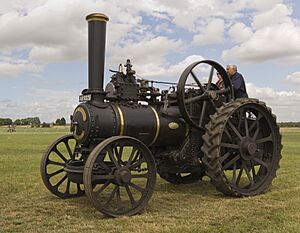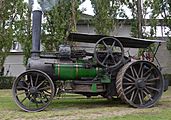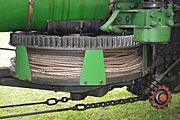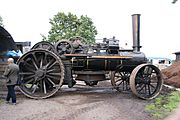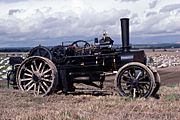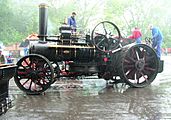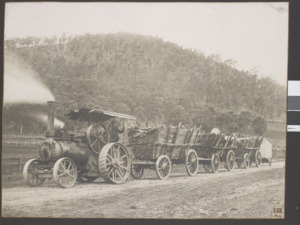John Fowler (agricultural engineer) facts for kids
Quick facts for kids
John Fowler
|
|
|---|---|
| Born | 11 July 1826 |
| Died | 4 December 1864 (aged 38) Ackworth, Yorkshire, England
|
| Occupation | Agricultural engineer |
| Spouse(s) | Elizabeth Lucy Pease |
| Children | five |
| Parent(s) | John and Rebecca Fowler |
John Fowler (born 1826, died 1864) was a clever English engineer. He was one of the first to use powerful steam engines for farming. His inventions helped farmers plough fields and dig drainage channels much faster. This made farming cheaper and allowed more land to be used for growing food around the world.
Contents
Early Life and New Ideas
John Fowler was born in Melksham, Wiltshire, England. His father was a rich merchant and a Quaker. John was the third of five sons.
When he finished school, John first worked for a corn merchant. But in 1847, he decided to follow his own path. He joined an engineering company called Gilkes Wilson and Company in Middlesbrough. This company built things like steam locomotives and engines for mines.
A Trip to Ireland and a New Goal
In 1849, John visited Ireland. At that time, Ireland was suffering from a terrible famine. Many people were hungry because their main crop, potatoes, had failed. A lot of farmland couldn't be used because it was too wet.
John saw this problem and felt he had to help. He believed there had to be a better way to drain the land. Farmers usually used a "mole plough" to dig hidden channels underground. This plough needed a lot of power to pull it. Horses were used, but they could only pull small ploughs.
John returned to England with a big idea. He wanted to create a horse-powered plough that could dig drainage channels more effectively.
Fowler's First Drainage Ploughs
John Fowler worked hard on his new ideas. He wanted to make ploughing and draining land much easier.
Horse-Powered Drainage Plough
John's first ploughing engine moved across the field by itself. It used a team of horses walking around a special winding machine called a capstan. This machine pulled a rope that was anchored at the other end of the field. The plough would dig a channel and lay drainage pipes as it moved.
John showed his invention in 1850. Even though he had some small problems, his plough could dig drains deep into heavy clay. People were very impressed and called it "the most important feature of the exhibition."
Improved Horse-Powered Plough
John then made his design even better. His new horse-powered plough stayed still at the edge of the field. Horses turned a vertical winch (a machine for winding a rope). This rope pulled the mole plough across the field.
When one channel was done, the rope and plough were moved to start the next one. This design was much better because the horses only pulled the plough, not the heavy engine. John showed this improved plough at the Great Exhibition in 1851. He won another silver medal for his work.
Steam Power for Farming
John Fowler had worked with steam engines before. He realized that steam power could be even better for his ploughs than horses.
Early Steam Plough Attempts
In 1852, John tried his first steam-driven plough. The steam engine had a winch and pulled itself across the field, dragging the plough. But this didn't work well. The steam engine was too heavy and got stuck in the soft ground.
However, John still made history that year. He received a patent for his "Improvements in Machinery for draining land." This was one of the first patents for using steam power in farming!
Successful Steam Drainage Plough
After the first try, John went back to his improved horse-plough design. He put a steam engine at the corner of the field. This engine had a winch that pulled the mole plough across the field.
To make it even more efficient, the engine had a second winch. This second rope pulled the plough back to the start after it finished a drainage line. John showed this amazing steam plough in 1854.
Steam Plough for Regular Fields
It seemed clear that John's steam plough could do more than just drainage. It could plough regular fields too! Normal ploughing was lighter work, usually done by horses. But John wanted his steam plough to be even better.
He designed a special plough frame that could plough in both directions. This meant the plough didn't need to be turned around at the end of each row. It had two plough blades, and one would swing down to work the soil depending on the direction.
In 1856, a trial showed that his engine could plough a whole acre in just one hour! However, moving the ropes and pulleys at the ends of the field took too much time.
John solved this problem by using special weighted carts with pulleys. These carts dug into the ground and acted as anchors. After ploughing a row, the carts would move to the next spot. John's system was shown at big farming events in 1856 and 1857. He eventually won a big £500 prize for his steam ploughing system in 1858.
Family Life
On July 30, 1857, John Fowler married Elizabeth Lucy Pease. She was the daughter of Joseph Pease, a Member of Parliament. Joseph Pease was a wealthy Quaker who had supported the building of the Stockton and Darlington Railway. John had met the Pease family while working in Middlesbrough.
John and Elizabeth settled in Essex and had five children: Emma Mary, Edith Rebecca, Laura Elizabeth, John Ernest, and Lucy Pease.
Double-Engine Ploughing System
In 1856, John came up with another clever idea. He thought about using two self-moving steam engines, one at each end of the field. Each engine would have a winch to pull the plough back and forth between them. This system didn't need separate pulleys or anchors.
This "double-engine" system was more expensive because it needed two engines. John kept working on his single-engine system because it was cheaper for average farmers. But eventually, the double-engine method became very popular, especially with contractors who did ploughing for many farmers.
John first showed his double-engine system in 1863. In 1864, he competed against his rivals, the Howard brothers, and won every prize!
- Fowler Winching Ploughing Engines
Later Career and Legacy
Between 1850 and 1864, John Fowler received 32 patents. These were for many different inventions, including ploughs, reaping machines, and traction engines.
By 1858, 40 sets of his ploughing machines were in use. By 1861, there were 100 sets! In 1860, the company Kitson and Hewitson started making his machinery. John also inspired other engineers, like Julius Kemna, to build and improve his steam-powered machines.
John Fowler and Company
In 1862, John partnered with William Watson Hewitson to form Hewitson and Fowler. When Hewitson died a year later, the company became John Fowler and Company.
John's ploughing machines were sold all over the world. They helped turn land that was once unusable into productive farmland.
Retirement and Sad End
John Fowler had worked incredibly hard on his inventions. This hard work took a toll on his health. He was told to rest more and moved to Ackworth to get better.
He started hunting for exercise. Sadly, during a hunt, he fell and broke his arm badly. While recovering, he got a serious infection called tetanus. John Fowler died on December 4, 1864, at only 38 years old. This was just months after his big win at the Newcastle ploughing trial.
His brothers, Robert, William, and Barnard, continued to run the company after his death. John Fowler's ploughing methods were used for many years. They were eventually replaced by modern tractors with internal combustion engines in the 20th century.
A monument to John Fowler's steam plough was placed in Darlington in 1856. The base of the monument can still be seen today.


